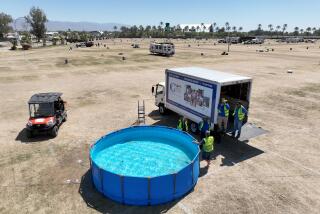Dramatic Changes to Reshape International Airport Area
LAX. Even the code name for this international airport evokes excitement, a feeling of change, a recollection of major road and terminal work completed on schedule in time for the 1984 Olympics.
But what of the areas around LAX? Through the years, they have changed too--from berry patches, oil refineries and raw dirt to slick high-rises, modern industrial buildings and park-like research centers as well as retail and residential developments. Yet, none of these changes was so dramatic as some that are planned.
Like Playa Vista, the Howard Hughes Development Corp.’s 15-year, master-planned commercial/residential project on 926 acres near Marina del Rey.
“That’s a city,” William S. Goodglick, a real estate broker who has worked in the airport area for nearly 29 years, said.
“It hasn’t emerged as quickly as Summa (parent company of the Howard Hughes Development Corp.) would like, but I think it will do for LAX what Century City did for Beverly Hills.” Both profited, he explained, by development of the old 20th Century Fox studio lot.
Playa Vista, which has been opposed by environmentalists and marina businessmen, is undergoing hearings for annexation to the city of Los Angeles, and construction work isn’t even expected to begin on its infrastructure until the fall of 1986, but Goodglick predicts that Playa Vista will “remarkably change” the skyline of what he calls “the Greater South Bay/LAX area” in the next 10 years.
Commercial Development
That skyline will also be changed by another master-planned project on airport property. Donald A. Miller, manager of airport properties, explained:
“It will be on 250 acres on the north side of LAX, and it involves recycling the property from old residential (lots acquired a few years ago by the airport after many lawsuits and other proceedings) to commercial and light office/industrial use, including some hotels. A major road extension of Westchester Parkway will also be built. When this is all built out, it will probably represent $900 million to $1 billion (in valuation).”
City Ordinance Awaited
The project, along with development of a 1,000-room hotel or office/hotel complex on an eight-acre parcel the airport owns on the southwest corner of Airport and Century boulevards, will move ahead, he said, when a proposed city ordinance relating to real estate development and traffic concerns in the LAX area is resolved. Anticipating this, the Department of Airport Commissioners decided to hire Albert C. Martin as the architectural firm in charge of master planning.
The proposed ordinance, known as the Los Angeles Coastal Transportation Corridor Specific Plan, was signed by the mayor Sept. 24. It will become law on Oct. 22.
The plan is a first to alleviate traffic. “Nothing like it has been done anywhere else in the country,” Dave Grannis, one of Los Angeles City Council President Pat Russell’s aides, said.
The ordinance will require developers of new industrial and commercial projects west of the San Diego Freeway, between El Segundo and Santa Monica (including Playa Vista), to pay for traffic improvements and, among other measures, institute car pools to reduce traffic. A developer will pay a one-time fee of $2,010 for each afternoon rush-hour trip generated by the new development. The fee was based on the cost of public improvements to accommodate a car over a 25-year period.
Through the Southern California Assn. of Governments, Russell initiated a study four years ago of several South Bay cities that led to the plan. “She saw that there would be a problem,” Grannis said.
Anyone who gets stuck during rush hour on the San Diego Freeway between Century Boulevard and Rosecrans Avenue can see that there is already a traffic problem there, but Russell’s plan will do little to ease this situation because the new ordinance will only involve streets in the city of Los Angeles. Traffic in El Segundo, which increased significantly with construction during the past five years of three office towers (one 24 stories in height), has been mitigated by a program using traffic officers at major intersections during rush hours, Goodglick (who proposed and helped fund the plan) said, but little if anything is being done to relieve traffic jams in neighboring cities.
Stanley A. Moore (whose 12-year-old Carson firm, Overton, Moore & Associates, has developed more than 12 million square feet of office, industrial and business space--much of it in the “Greater South Bay/LAX” vicinity) acknowledged that traffic in the beach cities is “terrible.” However, he added with a smile, “traffic creates value. That’s a real estate axiom, and I have to agree with it.”
He has made some efforts toward alleviating traffic, though, by developing low-rise instead of high-rise projects. His firm just completed the $140-million El Segundo Research Center and $40-million University Commercenter in the Carson area and is currently working on the $70-million Redondo Beach Business Court on the former site of Aviation High School.
These and other projects, such as an office development planned on a nine-acre parcel just sold through Goodglick in El Segundo, are continuing to change the skyline or, as Goodglick terms it, “urbanize” the area.
Actually, urbanization got ahead of itself, though just 18 months ago; there were some major land parcels where new projects stand. There are pockets in the Greater LAX/South Bay area where office and research-and-development structures have been overbuilt.
One is near the so-called “South Bay Curve” or intersection of the Harbor and San Diego freeways, where industrial real estate broker Stuart Klabin, who has had offices in Inglewood for nearly 25 years, said:
“A lot of developers built in anticipation of a big southerly movement of high-tech (users), but this movement didn’t happen. I know of one 205,000-square-foot research-and-development building that has been standing vacant for three years, and there are several other R&D; buildings that have not yet been occupied.”
Near the airport, especially along stretches of Century Boulevard, Klabin said, “there must be three to five years of (office) product standing. That means that it will take at least three years to absorb the office space even if no more is built.”
What saved some office developers in the airport area from going into foreclosure was what Klabin calls “the dynamics” of Hughes, TRW, Rockwell and Northrop, although El Segundo recently imposed an employee or head tax that had Hughes and other major employers fuming and even threatening to move their operations elsewhere.
“These companies have made a staggering impact,” he said. Referring to federal funds being spent on defense, he said, “There is an absolute correlation between who’s in power in Washington and how well real estate will do in this geographical area.”
The office market is doing better generally now than it did a year or so ago, John Ayoob of Coldwell Banker Commercial Real Estate Brokerage said. Office vacancy rates along 190th Street near the South Bay Curve have dropped below 20%, he noted, “and that might surprise a lot of people who think that it’s about 30%, but there have been a lot of large transactions there during the past eight or nine months.”
Steve Cramer of the same firm attributed these transactions to a general improvement in the economy as well as increased expenditures on aerospace work. Lack of multi-tenant space in El Segundo has helped the Century Boulevard office market, he said, estimating the vacancy rate there at 15% to 18%. A Grubb & Ellis survey released last month estimated the overall South Bay office vacancy rate in June at 23.6%, a 1.2% drop from March.
The South Bay office market has been recovering, but the industrial market appears to be in excellent health. David Drummond, vice president of the Seeley Co. and manager of the firm’s South Bay office, estimated that there is a 4% vacancy rate for industrial space in the South Bay area. Klabin observed:
“It’s a buyer’s market for research-and-development, but it’s a seller’s market for industrial.”
He did not mean industrial in the sense of old warehouses or manufacturing plants, because the cost of land near the airport is prohibitive for these kinds of uses anymore, he explained. The kind of industrial he was talking about is “high-tech,” such as data processing or airport-related activities like flight kitchens, or “a break-the-freight,” which he described as a “type of truck stop or platform with a roof and a whole lot of doors,” where air freight is uncrated, if necessary, and then shipped elsewhere.
Inglewood is probably the leading area city to cash in on these industrial needs. Through its very active redevelopment agency, projects valued at more than $130 million are either planned, under way or just completed. These represent a mix of development types, but industrial--primarily air-freight use--rates high, and Klabin is involved as a broker as well as a developer. KDI Partnership (he is the K) is developing a $4-million, 50,000-square-foot air-freight complex there.
Redevelopment is also catching on in Hawthorne. Goodglick attributes this to the proposed Century Freeway, which is expected to be under construction next March.
As LAX’s Miller observed, “The Century Freeway has been discussed for 20 years, but now it’s rapidly moving ahead.”
For the short term, construction of the freeway is adversely affecting small tenants, brokers say, but for the long term, everybody is optimistic.
As Goodglick voiced it:
“The Century Freeway is the next adrenalin shot to urbanization of the area.”
More to Read
Start your day right
Sign up for Essential California for news, features and recommendations from the L.A. Times and beyond in your inbox six days a week.
You may occasionally receive promotional content from the Los Angeles Times.






